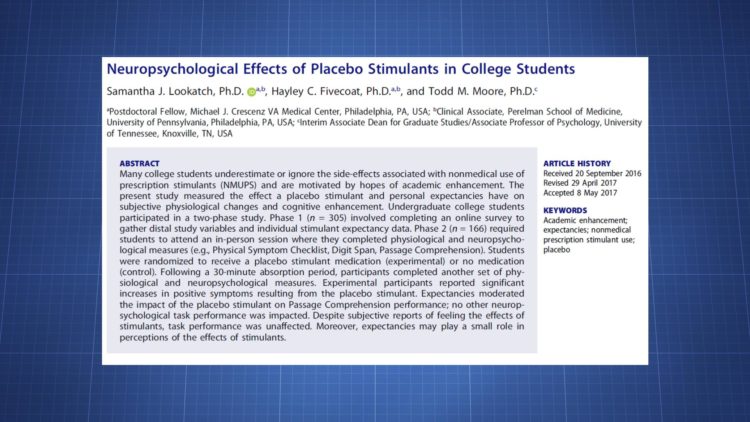TDC abstract: Placebo stimulants are capable of increasing self-reported alertness, focus, and positive mood. These effects are present in the absence of neuropsychological improvement, demonstrating a placebo, likely due to positive expectancies, can make users believe they’re receiving a benefit.
Authors: Samantha Lookatch, Hayley Fivecoat, and Todd Moore
DOI: 10.1080/02791072.2017.1344897
Link: https://www.ncbi.nlm.nih.gov/pubmed/28699832
Published: July 2017
Contents
Background
The level of nonmedical prescription stimulant use is fairly high among undergraduate and graduate students. In the US, lifetime use rates appear to be between 12% and 20%.
Many students believe stimulants like amphetamine and methylphenidate can improve performance. Those beliefs are expected to contribute to higher use rates and may contribute to the effects themselves.
While studies involving ADHD patients show they can have beneficial effects, studies on healthy well-rested people have yielded less significant results. We have little evidence to suggest that kind of population actually receives a significant cognitive boost from typical stimulants.
Differences between healthy and ADHD populations are known to exist. Methylphenidate is consistently preferred to placebo by ADHD users, yet controls have no significant preference (Kollins, 2009).
Research has shown positive and negative expectancies can drive real drug effects and placebo effects. And it’s expected a large number of students have positive expectancies regarding stimulants. One report found 71.4% of students know a peer who has used them nonmedically.
Currently, we still don’t fully understand how expectancies impact the effects of a placebo.
This paper had three core hypotheses:
- Administration of a placebo stimulant will enhance performance based on reading comprehension, short-term and working memory, and overall executive functioning.
- A placebo stimulant will, relative to controls, alter subjective effect scores.
- Positive expectancies will be associated with improved task performance, while negative expectancies won’t impact performance.
Methods
Phase 1
Initially gathered 305 undergraduate students. All were 18 to 24-years-old. None had a prescription for stimulants or a current/past ADHD diagnosis.
Phase 2
Reduce the initial 305 to 265 participants, of which 166 enrolled.
They were randomly assigned to experimental (n=86) and control (n=80) conditions.
Measures
Four neuropsychological tests were used: d2 Task of Attention, Paced Auditory Serial Addition Test (PASAT), Passage Comprehension from the Woodcock Johnson III, and Digit Span tests from the WAIS-IV and WISC-IV.
Participants were also given a Positive Symptom Rating Scale (5 items: alert, focus, energy, motivation, and pleasant mood.) And they received a Physiological Symptom Checklist (23 items covering side effects like dry mouth, shakiness, muscle pain, and dehydration.)
A ReliOn Automatic Blood Pressure Monitor was used to measure BP and HR at various time points. This could conceivably impact how much people are paying attention to their physical and psychological condition.
Experimental participants were asked to pick an oral “dose” of Ritalin, Adderall, or Focalin. They were told the study would measure task performance.
Options were given so that participants could pick the drug they were most familiar with, thereby boosting expectancies.
Results
Population
166 people.
- Mean age: 18.78
- Mean GPA: 3.45
- 73.5% Caucasian
Most participants were freshmen (71.1%) or sophomores (16.95%).
18% reported lifetime nonmedical use of stimulants. 19 of those individuals entered the experimental group, while 11 were placed in the control.
The majority of the experimental group (73.8%) picked Adderall for their “drug.”
Hypothesis 1a and 1b
Regardless of group, task performance significantly changed between T1 (time 1) and T2 (time 2).
There was a significant change on the PASAT between groups, with performance declining for the experimental group and improving for the control condition. The authors noted this should be viewed with caution since multivariate testing using Wilks’ criterion was nonsignificant.
However, the experimental group self-reported significant improvements in alertness, focus, and positive mood. While the control group reported declines. There was no change in terms of negative physical side effects.
Hypothesis 2
All participants cited academic-related reasons among their positive expectancies. Including improved focus (53.6%), improved attention/concentration (52.5%), improved grades/better studying (27.7%), and wakefulness/increased alertness (27.0%).
Positive expectancies failed to mediate any positive change on any neuropsychological task.
Negative expectancies were also present, including addiction/dependence (53.7%), health-related consequences (43.9%), ethical/moral issues (26.5%), and lack of sleep (22.8%).
Negative expectancies did moderate performance on the Passage Comprehension test. Experimental participants with higher negative expectancy scores exhibited improved performance vs. those with lower expectancies.
The controls showed the opposite correlation. Those with higher negative expectancy scores showed less improvement on the test vs. those with lower negative expectancies.
Summary
The authors note that these findings support research showing cognitive performance isn’t improved by methylphenidate vs. placebo in healthy people (Looby, 2011).
It’s possible the decline in PASAT performance came from increased distraction resulting from preoccupation with the placebo stimulant.
Results with the self-reported measures indicate people using these stimulants may experience “a more enhanced subjective perception of the effects of a stimulant, placebo or otherwise, than actually occurs.”
One would expect a person to experience the targeted changes, defined as “positive symptoms” in the present study, whereas people do not always experience the negative side-effects from a medication, as was the case with this placebo and the lack of physical symptom changes reported.
Overall, positive expectancy and positive evaluation scores did not moderate neuropsychological task performance. Negative expectancies (e.g., addiction, health consequences) did moderate performance on Passage Comprehension for experimental participants; those rating the negative expectancy as more salient outperformed their peers.
Based on earlier research, the authors found it surprising that task performance wasn’t improved by positive expectancies. The findings did, however, suggest expectancies may play a role in perceiving the effects of stimulants.
Despite self-reported subjective improvements in focus, alertness, and pleasant mood in the placebo group, participants did not perform better across task administrations overall. This substantiates prior research indicating that students’ beliefs that stimulant medications are cognitive enhancers are likely misconstrued.









